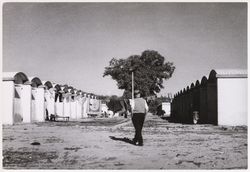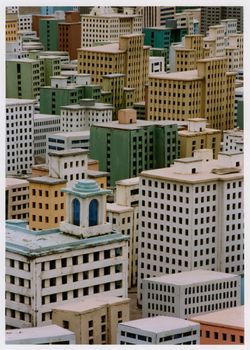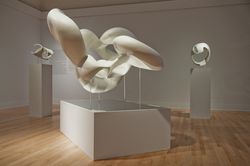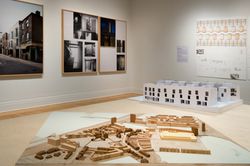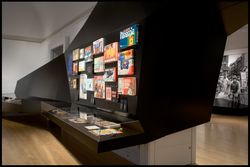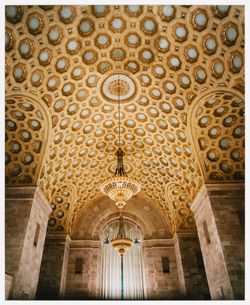archives
Level of archival description:
Fonds
Pierre Jeanneret fonds
AP156
Synopsis:
Le Fonds Pierre Jeanneret documente la pratique professionnelle et la vie personnelle de l'architect Pierre Jeanneret de ses études et ses projets professionels en Europe à ses projets architecturaux à Chandigarh, en Inde. Les documents du Fonds consistent en des photographies, des dessins et des documents textuels relatifs à plus de 100 projets, principalement son travail pour le projet de la nouvelle ville de Chandigarh, en Inde, en 1951 à 1965. *** The Pierre Jeanneret fonds documents the professional practice and the personal life of architect Pierre Jeanneret from student and professional work in Europe to architectural projects in Chandigarh, India. The documents in the fonds consist of photographs, drawings and textual records relating to over 100 projects, predominantly his work for the project of the new city of Chandigarh, in India, in 1951 to 1965.
1870s-2011
Pierre Jeanneret fonds
Actions:
AP156
Synopsis:
Le Fonds Pierre Jeanneret documente la pratique professionnelle et la vie personnelle de l'architect Pierre Jeanneret de ses études et ses projets professionels en Europe à ses projets architecturaux à Chandigarh, en Inde. Les documents du Fonds consistent en des photographies, des dessins et des documents textuels relatifs à plus de 100 projets, principalement son travail pour le projet de la nouvelle ville de Chandigarh, en Inde, en 1951 à 1965. *** The Pierre Jeanneret fonds documents the professional practice and the personal life of architect Pierre Jeanneret from student and professional work in Europe to architectural projects in Chandigarh, India. The documents in the fonds consist of photographs, drawings and textual records relating to over 100 projects, predominantly his work for the project of the new city of Chandigarh, in India, in 1951 to 1965.
archives
Level of archival description:
Fonds
1870s-2011
2016 Visiting Scholar Farhan Karim presents his research: In the recent development of architectural history, the involvement of Western architects in emerging postcolonial nations has been reviewed within the broader geopolitics of decolonization and global cold war. That analysis is certainly correct, as far as it goes, but what is needed historiographically is nuanced(...)
Shaughnessy House
7 July 2016, 6pm
Visiting Scholar Seminar: Farhan Karim
Actions:
Description:
2016 Visiting Scholar Farhan Karim presents his research: In the recent development of architectural history, the involvement of Western architects in emerging postcolonial nations has been reviewed within the broader geopolitics of decolonization and global cold war. That analysis is certainly correct, as far as it goes, but what is needed historiographically is nuanced(...)
Shaughnessy House
A conversation between Japanese photographer Naoya Hatakeyama and CCA visiting curator Hubertus von Amelunxen on the exhibition Naoya Hatakeyama: Scales. Commissioned by the CCA, Naoya Hatakeyama created three photographic series of architectural models that challenge notions of scale and the perception of reality. He speaks about the series in the context of his work,(...)
Paul Desmarais Theatre
27 September 2007
Naoya Hatakeyama and Hubertus von Amelunxen in Conversation
Actions:
Description:
A conversation between Japanese photographer Naoya Hatakeyama and CCA visiting curator Hubertus von Amelunxen on the exhibition Naoya Hatakeyama: Scales. Commissioned by the CCA, Naoya Hatakeyama created three photographic series of architectural models that challenge notions of scale and the perception of reality. He speaks about the series in the context of his work,(...)
Paul Desmarais Theatre
Other Space Odysseys presents three approaches to the idea of an adventurous journey that started forty years ago after the 1969 moon landing. Featuring the work of architects Greg Lynn, Michael Maltzan, and Alessandro Poli, Other Space Odysseys comes at a time when space exploration is the subject of renewed enthusiasm, but also of debate which questions its(...)
Main galleries
8 April 2010 to 19 September 2010
Other Space Odysseys: Greg Lynn, Michael Maltzan, Alessandro Poli
Actions:
Description:
Other Space Odysseys presents three approaches to the idea of an adventurous journey that started forty years ago after the 1969 moon landing. Featuring the work of architects Greg Lynn, Michael Maltzan, and Alessandro Poli, Other Space Odysseys comes at a time when space exploration is the subject of renewed enthusiasm, but also of debate which questions its(...)
Main galleries
Project
Inter-Action Centre
AP144.S2.D82
Description:
File documents Inter-Action Centre, a completed project for a community centre commissioned by Ed Berman and the Inter-Action Trust, for a disused site at Talacre Public Open Space in Kentish Town, Camden, London. The construction was divided into two phases. Foundations, steel frame and trusses were constructed first and could be used for open-air community events while funds were being raised for the second phase. Phase II included cladding, fittings, finishes, services prefabricated units, and log cabins. The building was intended as a flexible short life-span building in which the interior spaces would be independent of the roof and exterior walls. Functional areas suggested by Cedric Price include: assembly halls, classrooms, rehearsal rooms, studios, areas for performance, media resources, lounging and dining, and a gym and a nursery. Cedric Price had been engaged by the concepts of flexible architecture, indeterminacy, impermanence, and the fusion of information technology, entertainment, and educational activities in earlier unrealized projects such as Fun Palace (AP144.S2.D46) and Oxford Corner House (AP144.S2.D59). Existing conditions drawings include photographs of the site; reprographic copies of electrical and drainage systems; ordinance surveys of Kentish Town; and landscape and playground layout. Conceptual drawings include sketches of overall massing; diagrammatic plans; drawings and diagrams of site conditions; notes for the structural framework; rendered interior elevations; plans showing impact of site context on building design; diagrammatic sketches of relationship between functional requirements and structural form. Schematic drawings include diagrammatic plans; sections of structural system and exterior wall; cladding details; and axonometric views of supports. Design development drawings and working drawings include plans, elevations, sections, details and axonometric views. Presentation drawings include watercolours and other renderings; reprographic copies, possibly for publication; and perspectives drawings. Some material from this file was published in "Inter-action Centre." 'RIBA Journal'. (November 1977), 458-465; "Intervista A Cedric Price: London Interaction Centre." 'Domus'. (April 1978), 17-21; "Kentish Town West Amalgam, London." 'Architectural Record'. (January 1973), 19; Lyall, Sutherland. 'The State of British Architecture'. (London: Architectural Press, 1980), 107-109; 130 and 'Cedric Price-Works II' (London: Architectural Press, 1984), 54, 62-63. Material in this file was produced between 1964 and 1992, but predominantly between 1970 and 1981. File contains technical drawings that are attributed to the following consultants, contractors, and manufacturers: Coseley Buildings Ltd; H.G. Deacon Ltd; Kayanson Engineers; H.J. Knights & Co. Ltd; Woodcemair; Metal Sections Ltd; Spaceway; Gascoigne, Gush & Dent (Engineering Ltd); UBM Engineering; J. Murphy & Sons Ltd; Maurice Pickering Associates, Architects & Landscape Consultants; David Lee Architect & Landscape Architect; J. Starkie Gardner Ltd; Dibben Structural Engineers; Zisman, Bowyer & Partners; Felix J. Samuely and Partners; Ruberoid Contracts Ltd; Whitbread London Limited; and Portakabin. Paul Hyett and Will Alsop were Cedric Price's main assistants for this project. 'Inter-Action Trust Limited', 'Inter-Action Centre', and 'Talacre Centre Limited' appear as the client(s) at various stages of this project. File contains cartographic materials, conceptual drawings, consultant drawings, design development drawings, models, panels, photographic materials, presentation drawings, an illustration, textual records, and working drawings.
1964-1992, predominant 1970-1981
Inter-Action Centre
Actions:
AP144.S2.D82
Description:
File documents Inter-Action Centre, a completed project for a community centre commissioned by Ed Berman and the Inter-Action Trust, for a disused site at Talacre Public Open Space in Kentish Town, Camden, London. The construction was divided into two phases. Foundations, steel frame and trusses were constructed first and could be used for open-air community events while funds were being raised for the second phase. Phase II included cladding, fittings, finishes, services prefabricated units, and log cabins. The building was intended as a flexible short life-span building in which the interior spaces would be independent of the roof and exterior walls. Functional areas suggested by Cedric Price include: assembly halls, classrooms, rehearsal rooms, studios, areas for performance, media resources, lounging and dining, and a gym and a nursery. Cedric Price had been engaged by the concepts of flexible architecture, indeterminacy, impermanence, and the fusion of information technology, entertainment, and educational activities in earlier unrealized projects such as Fun Palace (AP144.S2.D46) and Oxford Corner House (AP144.S2.D59). Existing conditions drawings include photographs of the site; reprographic copies of electrical and drainage systems; ordinance surveys of Kentish Town; and landscape and playground layout. Conceptual drawings include sketches of overall massing; diagrammatic plans; drawings and diagrams of site conditions; notes for the structural framework; rendered interior elevations; plans showing impact of site context on building design; diagrammatic sketches of relationship between functional requirements and structural form. Schematic drawings include diagrammatic plans; sections of structural system and exterior wall; cladding details; and axonometric views of supports. Design development drawings and working drawings include plans, elevations, sections, details and axonometric views. Presentation drawings include watercolours and other renderings; reprographic copies, possibly for publication; and perspectives drawings. Some material from this file was published in "Inter-action Centre." 'RIBA Journal'. (November 1977), 458-465; "Intervista A Cedric Price: London Interaction Centre." 'Domus'. (April 1978), 17-21; "Kentish Town West Amalgam, London." 'Architectural Record'. (January 1973), 19; Lyall, Sutherland. 'The State of British Architecture'. (London: Architectural Press, 1980), 107-109; 130 and 'Cedric Price-Works II' (London: Architectural Press, 1984), 54, 62-63. Material in this file was produced between 1964 and 1992, but predominantly between 1970 and 1981. File contains technical drawings that are attributed to the following consultants, contractors, and manufacturers: Coseley Buildings Ltd; H.G. Deacon Ltd; Kayanson Engineers; H.J. Knights & Co. Ltd; Woodcemair; Metal Sections Ltd; Spaceway; Gascoigne, Gush & Dent (Engineering Ltd); UBM Engineering; J. Murphy & Sons Ltd; Maurice Pickering Associates, Architects & Landscape Consultants; David Lee Architect & Landscape Architect; J. Starkie Gardner Ltd; Dibben Structural Engineers; Zisman, Bowyer & Partners; Felix J. Samuely and Partners; Ruberoid Contracts Ltd; Whitbread London Limited; and Portakabin. Paul Hyett and Will Alsop were Cedric Price's main assistants for this project. 'Inter-Action Trust Limited', 'Inter-Action Centre', and 'Talacre Centre Limited' appear as the client(s) at various stages of this project. File contains cartographic materials, conceptual drawings, consultant drawings, design development drawings, models, panels, photographic materials, presentation drawings, an illustration, textual records, and working drawings.
File 82
1964-1992, predominant 1970-1981
research
Visiting Scholars 2001–2002
Theme: The Phenomenon of Paradigm Shifts in Architecture since Antiquity: Brigitte Desrochers, National Gallery of Canada, Ottawa, Canada Topic: Au-delà du style. Naissance du classicisme structurel dans les ruines de Pompei Joseph Disponzio, Graduate School of Design, Harvard University, Cambridge, United States Topic: Jean-Marie Morel and the Invention of Landscape(...)
September 2001 to August 2002
Visiting Scholars 2001–2002
Actions:
Description:
Theme: The Phenomenon of Paradigm Shifts in Architecture since Antiquity: Brigitte Desrochers, National Gallery of Canada, Ottawa, Canada Topic: Au-delà du style. Naissance du classicisme structurel dans les ruines de Pompei Joseph Disponzio, Graduate School of Design, Harvard University, Cambridge, United States Topic: Jean-Marie Morel and the Invention of Landscape(...)
research
September 2001 to
August 2002
As part of the CCA’s ongoing exploration of key issues in contemporary architecture with a specific focus on urban, social, and environmental concerns, Some Ideas on Living in London and Tokyo by Stephen Taylor and Ryue Nishizawa features recent architectural projects that propose new solutions to the challenges of building homes in dense urban environments. London and(...)
Main galleries
14 May 2008 to 26 October 2008
Some Ideas on Living in London and Tokyo by Stephen Taylor and Ryue Nishizawa
Actions:
Description:
As part of the CCA’s ongoing exploration of key issues in contemporary architecture with a specific focus on urban, social, and environmental concerns, Some Ideas on Living in London and Tokyo by Stephen Taylor and Ryue Nishizawa features recent architectural projects that propose new solutions to the challenges of building homes in dense urban environments. London and(...)
Main galleries
archives
Level of archival description:
Fonds
Bernard Tschumi fonds
AP214
Synopsis:
The Bernard Tschumi fonds, dating from approximately 1965-2015, documents the professional activities of Bernard Tschumi including Tschumi’s career in academia and his professional practice as an architect through approximately 75 projects dating from the late 1980s to 2012.
circa 1964-2015
Bernard Tschumi fonds
Actions:
AP214
Synopsis:
The Bernard Tschumi fonds, dating from approximately 1965-2015, documents the professional activities of Bernard Tschumi including Tschumi’s career in academia and his professional practice as an architect through approximately 75 projects dating from the late 1980s to 2012.
archives
Level of archival description:
Fonds
circa 1964-2015
1973: Sorry, Out of Gas
1973: Sorry, Out of Gas captures the architectural innovation spurred by the 1973 oil crisis, when the value of oil increased exponentially and triggered economic, political, and social upheaval across the world. Featuring over 350 objects including architectural drawings, photographs, books and pamphlets, archival television footage, and historical artefacts, it maps the(...)
7 November 2007 to 20 April 2008
1973: Sorry, Out of Gas
Actions:
Description:
1973: Sorry, Out of Gas captures the architectural innovation spurred by the 1973 oil crisis, when the value of oil increased exponentially and triggered economic, political, and social upheaval across the world. Featuring over 350 objects including architectural drawings, photographs, books and pamphlets, archival television footage, and historical artefacts, it maps the(...)
Money Matters: A Critical Look at Bank Architecture surveys the history and cultural significance of bank architecture, focusing on bank architecture as a building typology rather than in the context of a single architect or architectural firm. Challenging the standard notion that bank buildings are repetitive, dull and conservative, the exhibition reveals banks as(...)
Main galleries
14 November 1990 to 24 February 1991
Money Matters: A Critical Look at Bank Architecture
Actions:
Description:
Money Matters: A Critical Look at Bank Architecture surveys the history and cultural significance of bank architecture, focusing on bank architecture as a building typology rather than in the context of a single architect or architectural firm. Challenging the standard notion that bank buildings are repetitive, dull and conservative, the exhibition reveals banks as(...)
Main galleries
